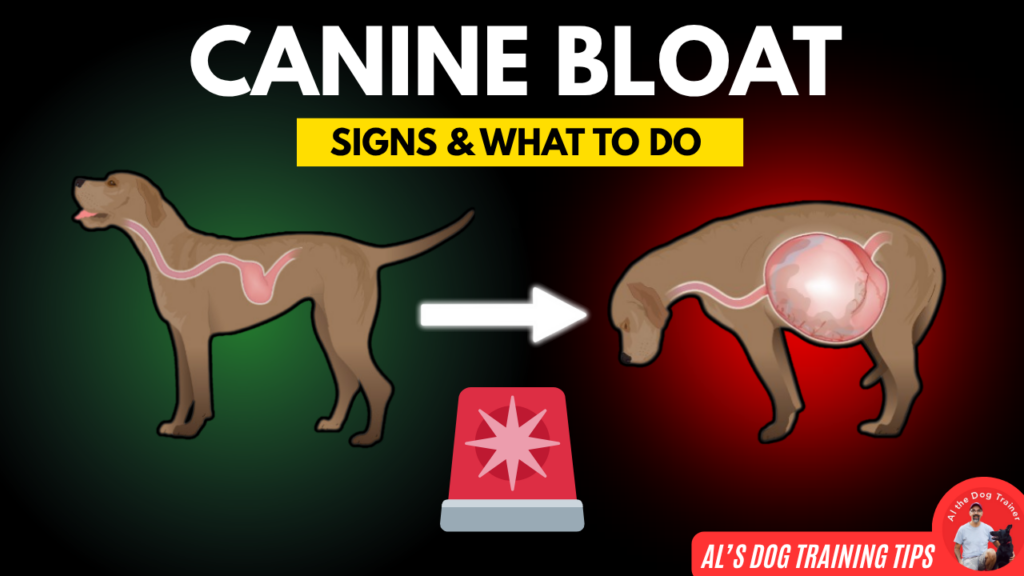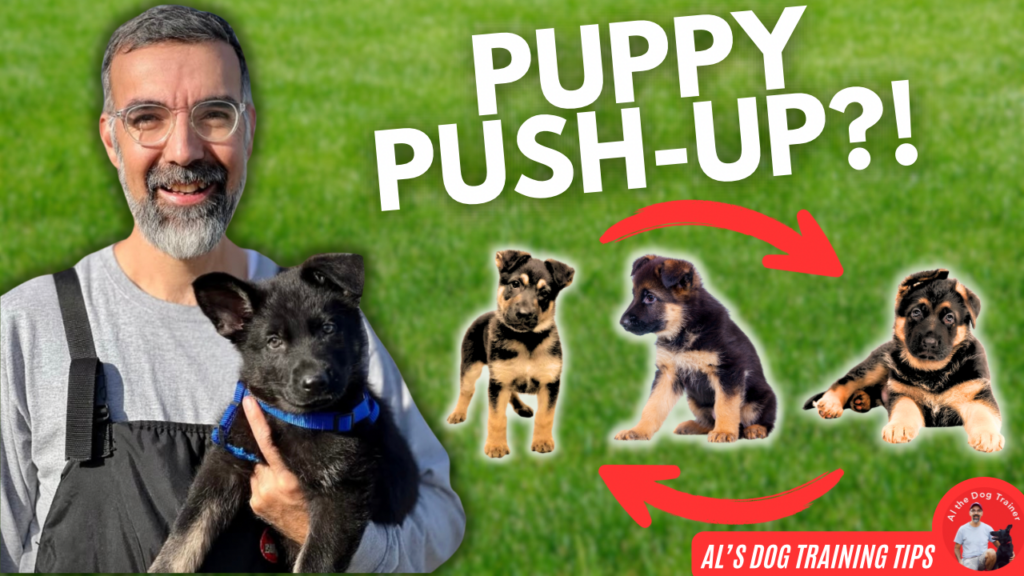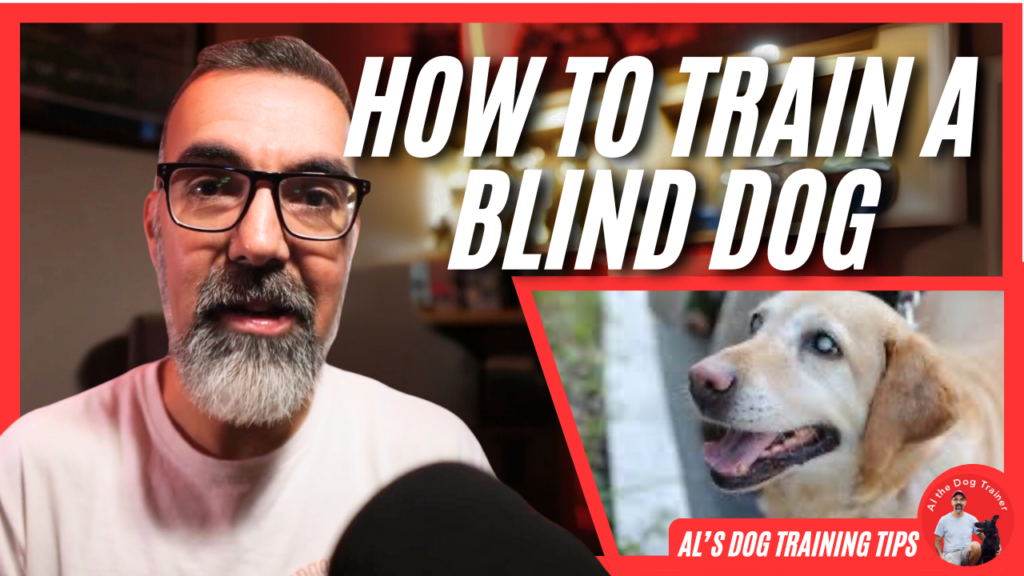Canine Bloat: What to Look for & What to Do
Howdy pack, and welcome back to Al’s Dog Training Tips!
Today’s topic isn’t a training tip in the traditional sense, but it’s something that every dog owner absolutely must be aware of: Canine Bloat, also known as Gastric Torsion or Gastric Dilatation-Volvulus (GDV).
This is a life-threatening emergency that can come on quickly and have fatal consequences if not treated immediately. As someone who works with dogs every single day, their health and safety are my top priorities. That’s why I’m dedicating this episode to helping you recognize, prevent dog bloat, and act quickly in the face of bloat.
What is Canine Bloat?
Canine bloat occurs when a dog’s stomach fills with gas and may twist (torsion), cutting off blood flow to vital organs. Without immediate veterinary care, it can be fatal within hours.
These aren’t just theoretical risks; bloat in dogs is a very real and very dangerous condition. But the good news is, while you can’t eliminate the risk entirely, there are steps you can take to reduce it and respond appropriately if it ever happens.
Al’s 6 Tips to Help Prevent Canine Bloat
1. Be Prepared with an Emergency Vet Contact
Know the location and phone number of your nearest emergency veterinary clinic. Program it into your phone today. In a bloat situation, every second counts. Don’t waste precious time looking it up in a panic. As your partners in dog training in Kingwood, Humble, and Crosby, TX, we teach that preparedness extends beyond commands to all areas of your dog’s well-being.
2. Watch Water Intake After Exercise
After heavy activity, allow your dog to calm down and return to a normal breathing rate before offering water. Chugging large amounts of water immediately after exercise can contribute to stomach distension.
3. Avoid Meals Right Before or After Exercise
Don’t feed your dog a full meal an hour before or after intense activity. A full stomach combined with movement increases the chance of the stomach twisting, which is a major risk factor for canine bloat. Give time for digestion.
4. Be Mindful of Evening Routines
Avoid heavy meals, vigorous exercise, or lots of water intake late at night. If bloat happens while you’re asleep, you might miss early symptoms of bloat in dogs, delaying critical care.
5. Know What ‘Normal’ Feels Like
Gently feel your dog’s stomach after meals or water intake so you become familiar with what’s normal. This way, you’ll more easily recognize unusual tightness or swelling that could indicate bloat.
6. Plan for Emergency Transport
In an emergency, can you physically lift your dog and get them into a vehicle? If not, have a backup plan. Know who to call and make sure they’re available. This is not something you want to figure out during a crisis. Being a responsible dog owner does not only apply during obedience training, but also applies to your dog’s health and well-being.
Signs of Bloat: Know What to Look For
If you notice any of the following signs, DO NOT WAIT, get to an emergency vet immediately:
Restlessness or pacing: Your dog might seem generally restless or exhibit specific pacing dog symptoms, unable to find a comfortable position or won’t lie down. This can also manifest as being restless after eating, constantly moving.
Inability to settle or get comfortable: Your dog may appear agitated, in pain, or simply unable to get comfortable.
Unproductive retching (trying to vomit but nothing comes out): This is a classic and critical sign of dog bloat: your dog tries to vomit repeatedly but nothing, or very little, comes out (often described as dog dry heaving without vomiting).
Excessive drooling: Increased salivation in your dog can be a sign of severe discomfort
A tight, swollen, or distended abdomen: You might observe obvious dog stomach swelling, making your dog’s belly feel hard and enlarged. If you notice my dog has a bloated stomach, especially after eating, this is a major red flag for an emergency dog bloat situation.
You don’t need to see all of these symptoms, just one could be cause for concern. When in doubt, act fast.
Don’t Try to Handle This at Home!
If you suspect your dog has bloat, go to the emergency vet immediately. Time is critical, and trying to treat bloat at home could cost your dog their life. Here are some key emergency veterinary clinics serving our Kingwood, Humble, and Crosby communities to have on hand:
- Animal Emergency Clinic Northeast in Humble, TX
For urgent, but not life-threatening, situations, UrgentVet Kingwood in Kingwood, TX may be an option, but for severe emergencies like bloat, they advise going directly to a 24/7 emergency hospital.
Crosby Veterinary Clinic in Crosby, TX. They offer urgent care and can provide referrals for after-hours emergencies to places like Animal Emergency Clinic Northeast).
Final Thoughts
Please take this seriously. Program your emergency vet’s number into your phone. Think through your plan for getting your dog to help, and share this information with every dog owner you know. This knowledge could literally save a life.
Thanks for tuning in to Al’s Dog Training Tips. While this episode wasn’t about obedience or behavior, I hope it helps you be a more informed and prepared dog owner. If you’re in Kingwood, Humble, or Crosby, TX, and looking for expert dog training, remember that a healthy dog is a happy dog, and we’re here to help with both!
Stay safe out there, and see you next time!






